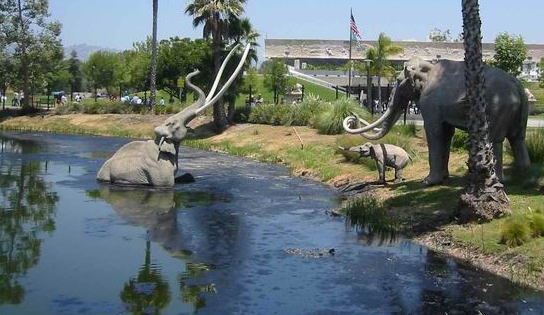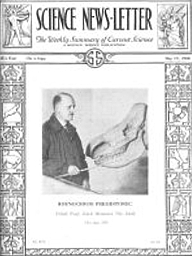
The La Brea Tar Pits, located in Los Angeles, California, are a famous site where scientists have found a large collection of fossils preserved in tar. Among these fossils are mammoths, saber tooth tigers, wide variety of insects, etc. Here is the common evolutionary explanation for these fossils (and the same explanation I remember being taught in school):
|
|
All this sounds good on the surface, but under close examination, it does not match the scientific evidence found. For example:
"Non-skeletal components such as hair, skin, feathers, claw sheaths, scales, tendons, muscles, and internal organshave never been found at the La Brea site. The disappearance of this material has prompted some discussion regarding the causal factors."
-William Weston, "La Brea Tar Pits: Evidence of a Catastrophic Flood," CRS Quarterly, Vol 40, No 1, p. 25-33, June, 2003
The major problem here is that the tar found at La Brea is mostly bitumen (petroleum or crude oil), and bitumen has been well-known in the past as a preservative:
"The use of bitumen in Egyptian mummies was important beginning at the end of the New Kingdom (after 1100 BC)--in fact the word from which mummy is derived ‘mumiyyah’ means bitumen in Arabic."
-K. Kris Hirst, "Bitumen: A Smelly but Useful Material of Interest," About.com Dictionary of Archeology, retrieved May 5, 2011, [http://archaeology.about.com/od/bcthroughbl/qt/bitumen.htm]; See also A. Nissenbaum, "Molecular Archaeology: Organic Chemistry of Egyptian Mummies", Journal of Archaeology, 1992, Vol 19, p. 1–6
That means, if the animals actually fell into this tar pit and got trapped, we would find large amounts of preserved hair, feathers, skin, scales, etc. However, because these are not found, we cannot conclude these tar pits were a "trap" for animals over a long period of time.
In addition, the evolutionists' claim for the rapid gathering of these creatures into the pits is the attraction of meat by preditors, however, "Two views of the tibia of a large lion, Panthera atrox, showing teeth marks." -C. Stock, "Significance of abraded and weathered mammalian remains from Rancho La Brea," Bulletin of Southern California Academy of Sciences, 1929, Vol 28, p. 1–5; See also William Weston, "La Brea Tar Pits: Evidence of a Catastrophic Flood," CRS Quarterly, Vol 40, No 1, p. 25-33, June, 2003 |
 |
As we can see, the evolutionary explanation doesn't stand up to scientific reasoning. There is one very interesting fact to note -- repeatedly
 |
In Poland, a rhinoceros, dating back at least many tens of thousands of years, was discovered completely intact and perfectly preserved in a similar fashion to the La Brea Tar Pits, only it had skin, hair, and muscles preserved as well.
"Skin, hair, muscles, and all other tissues were well preserved, owing to the sealing up of the monster in a kind of oily earth, which kept out the microorganisms of decay for many thousands of years." -"Polish Rhinoceros," Science Newsletter, May 17, 1930, Vol 27, p. 319 |
An autopsy revealed that the animal had drown before it was buried in oil:
"It was observed that only the skin of the left side was damaged during the influx of sediment into the interior of the animal. It would thus appear that the animal had fallen victim to some type of catastrophe, such as the overflowing of a river, and the dead body was swept away by thesurge of water ... On the dry areas of the rhino carcass was a crust of salt, even though, it must be concluded, the skin was soaked with an oily fluid.... This may incline us to assume that—along with fresh water—salt water was also present,"
-F. Lengersdorf, "Dipteren aus den diluvialen Schichten von Starunia," Starunia, 1934, Vol 4, p. 1; See also William Weston, "La Brea Tar Pits: Evidence of a Catastrophic Flood," CRS Quarterly, Vol 40, No 1, p. 25-33, June, 2003
"[M]uch of the material from the La Brea deposits appears badly abraded, probably bywater transport from adjacent hills."
-J. T. Doyen & S. F. Miller, "Review of Pleistocene Darkling Ground Beetles of the California Asphalt Deposits," Pan-Pacific Entomology, 1980, Vol 56, No 1, p. 1–10
Also, take note of the insects discovered in the La Brea Tar Pits. They found many beetles all dismembered in the same way, with their eyes, brains, esophagi, pharynges, antennae, mouthparts, and other pieces all missing from the body.
"Cephalic capsule of Nicrophorus, a carrion beetle, showing the foramen magnum in the underside view on the left and the empty eye sockets in the dorsal view on the right." -W. D. Pierce, "Fossil Arthropods of California: The Silphid Burying Beetles in the Asphalt Deposits," Bulletin of Southern California Academy of Sciences, 1946, Vol 48, p. 55–70 |
 |
"Cleaning the specimens can be a time-consuming and laborious process. A museum worker put chunks of asphalt into kerosene-filled jars for a week. Afterwards, the softened contents were placed on a tray containing benzene. Two more weeks of soaking elicited a loose assemblage of disarticulated heads, legs, wings, abdomens, thoraxes, and antennae. To clean out the body cavities, a worker placed specimens in xylene for another prolonged soaking. The next step was to use a fine needle to probe and excavate the inner matrix, cautiously and painstakingly to avoid damaging the specimen. Gentle brushing with a camel’s hair brush removed the loosened debris."
-W. D. Pierce, "Fossil Arthropods of California: Exploring the Minute World of the California Asphalt Deposits," Bulletin of Southern California Academy of Sciences, 1946, Vol 45, p. 113–118
If buried in tar, these parts should still be intact, so
"To test the effects of water on an insect, the present author put a live cockroach inside a 5-quart plastic bucket half-filled with water and placed it outdoors. The bucket had a lid punctured with air holes. The insect swam on the surface of the water but was dead the next day and continued to float. There were no changes until the third week, when the rear portion of the abdomen broke off and sank to the bottom. Later the rear portion returned to the surface. Gradually, over the next two months, antennae and leg segments detached and floated, along with the rest of the body. Bubbles formed around the openings of the main body and rear portion. Fluids seeped out and produced a pinkish film that clung to the bottom and sides of the bucket. By the fourth month another eruption occurred, leaving a gaping hole in the main portion. From this hole, more fluids and organs emerged. Later the head detached and floated. By the sixth month, the parts sunk to the bottom of the bucket.
Probably the buildup of gases associated with decomposition caused the ruptures and disintegration. The results of this exercise show that a prolonged period in water can dismember an insect, remove its inner organs, and scatter its remains. These effects are comparable to what appears in the insect material of Rancho La Brea."
-William Weston, "La Brea Tar Pits: Evidence of a Catastrophic Flood," CRS Quarterly, Vol 40, No 1, p. 25-33, June, 2003
Do we know for certain what happened to the creatures in Rancho La Brea? No, and perhaps we never will. But we CAN demonstrate that the evolutionary explanation is false. Scientific experiment shows us strong evidence that indicates flood waters involved in the decay of organisms that were later deposited in these tar pits.
The theory that these creatures were deposited into this area makes much more sense than to say they got trapped there, especially since we have no scientific evidence of that evolutionary explanation, but evolutionists will continue to believe it anyway because they have religious presuppositions about the world. Those presuppositions force evolutionists to deny any evidence against their theory, even if it defies common sense, lest they find an answer that involves the God of the Bible. The evolutionists' theory on the tar pits is based on pure imagination, and we must beware when they teach assumptions instead of real science.













![There is No Saving Grace Without Repentance [creationliberty.com]](../images/store13a.jpg)
![Why Christians Should Study The King James Bible [creationliberty.com]](../images/store15a.png)
![Wolves in Costume: Kent Hovind [creationliberty.com]](../images/store11a.jpg)
![Corruptions of Christianity: Seventh-day Adventism [creationliberty.com]](../images/store09a.png)
![501c3: The Devil's Church [creationliberty.com]](../images/store07a.jpg)
![Feminism: Castrating America [creationliberty.com]](../images/store04a.jpg)










![Why Millions of Believers on Jesus Are Going to Hell [creationliberty.com]](images/store05a.jpg)
![Corruptions of Christianity: Catholicism [creationliberty.com]](http://www.creationliberty.com/images/store14a.jpg)
![False Prophet Profiles: Kim Clement [creationliberty.com]](http://www.creationliberty.com/images/store12a.jpg)
![Christmas: Rejecting Jesus [creationliberty.com]](http://www.creationliberty.com/images/store10a.jpg)
![Christian Music: For The Love of Money [creationliberty.com]](images/store08a.png)
![Psychology: Hoodwinked by the Devil [creationliberty.com]](images/store06a.jpg)
